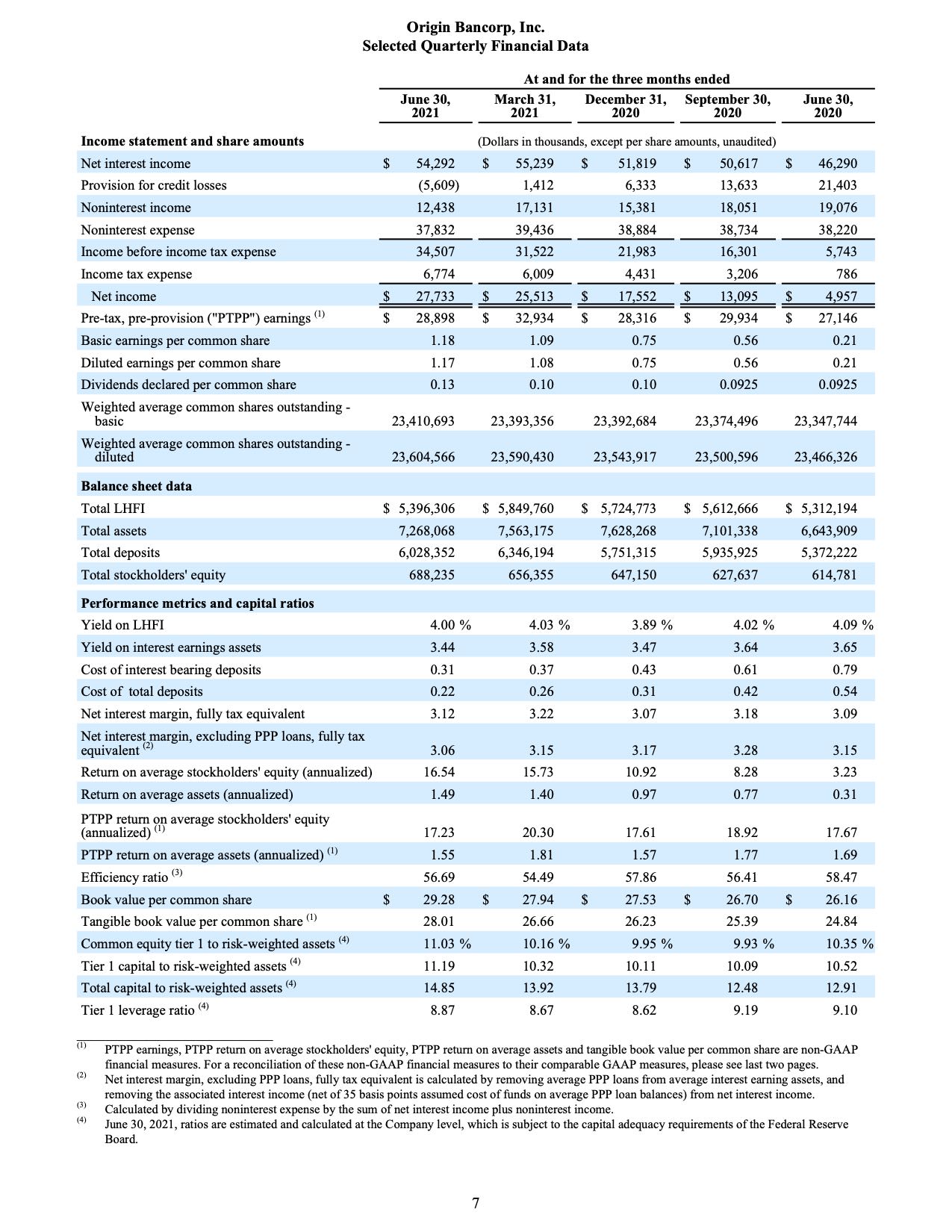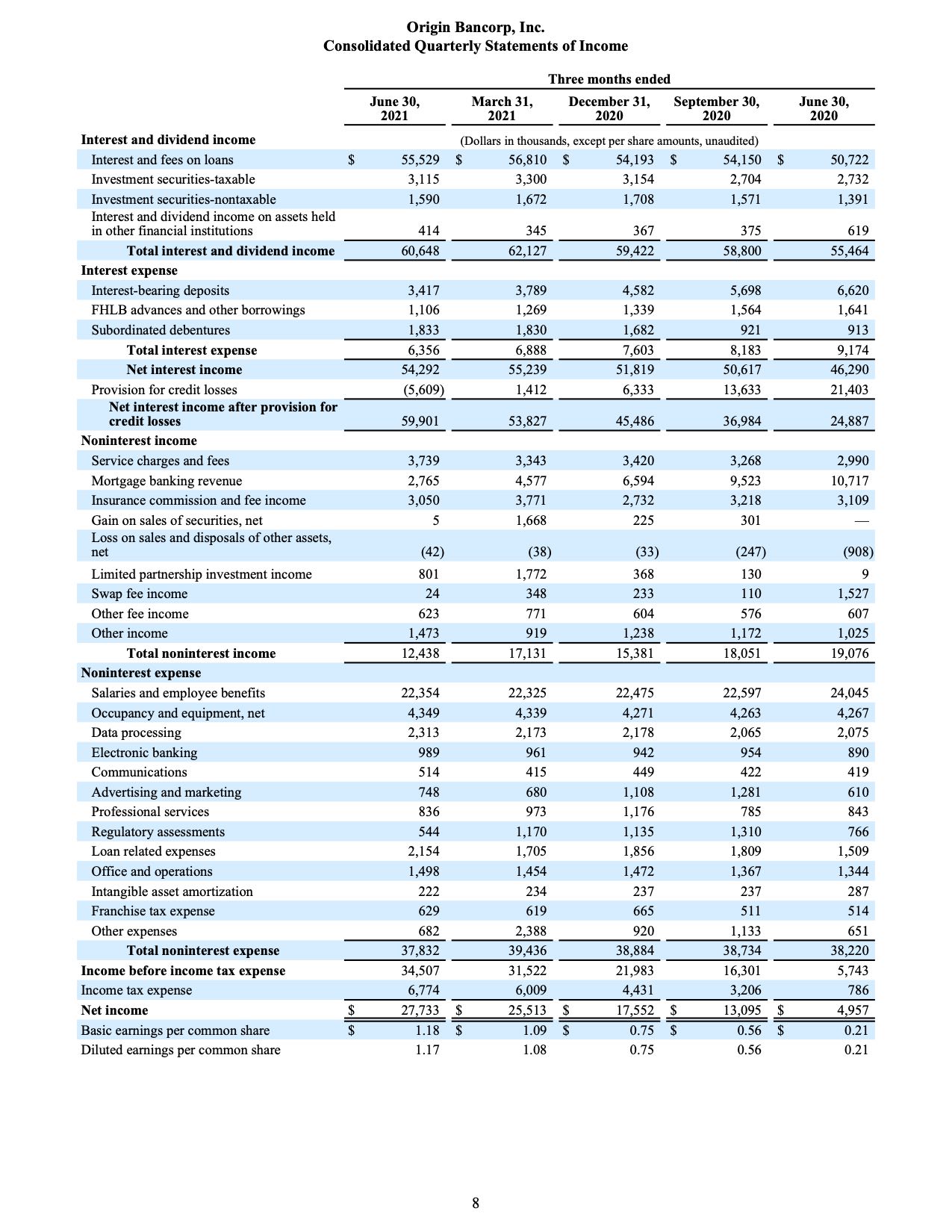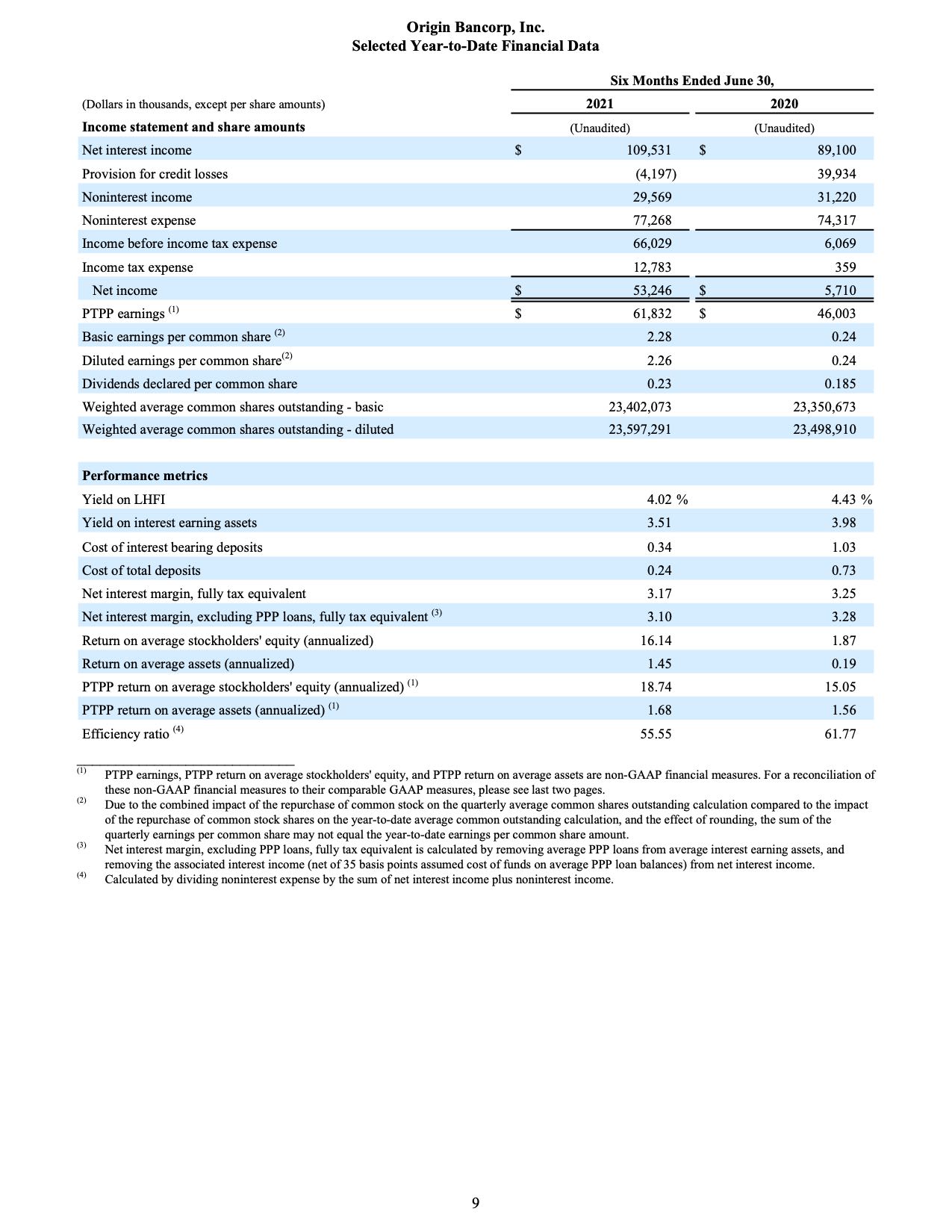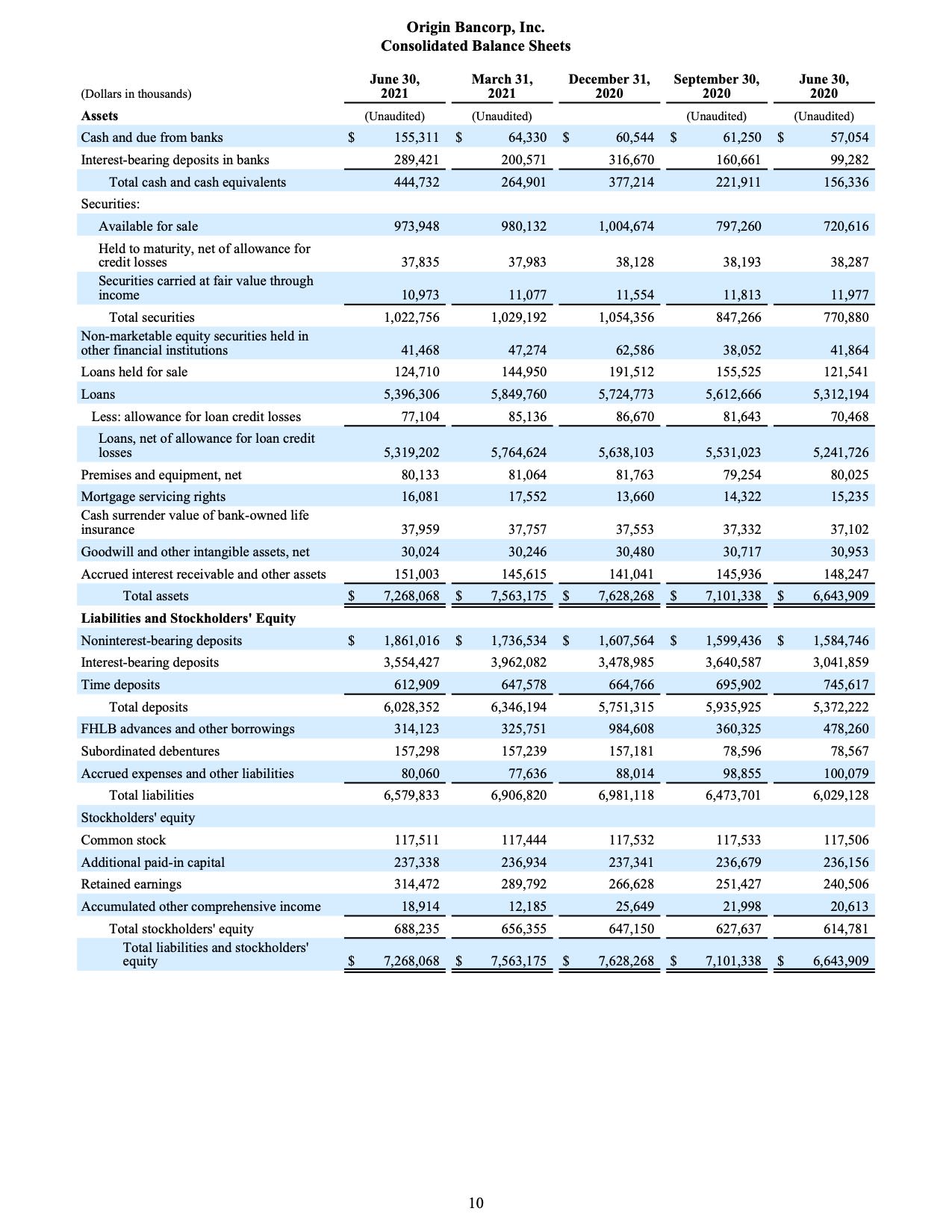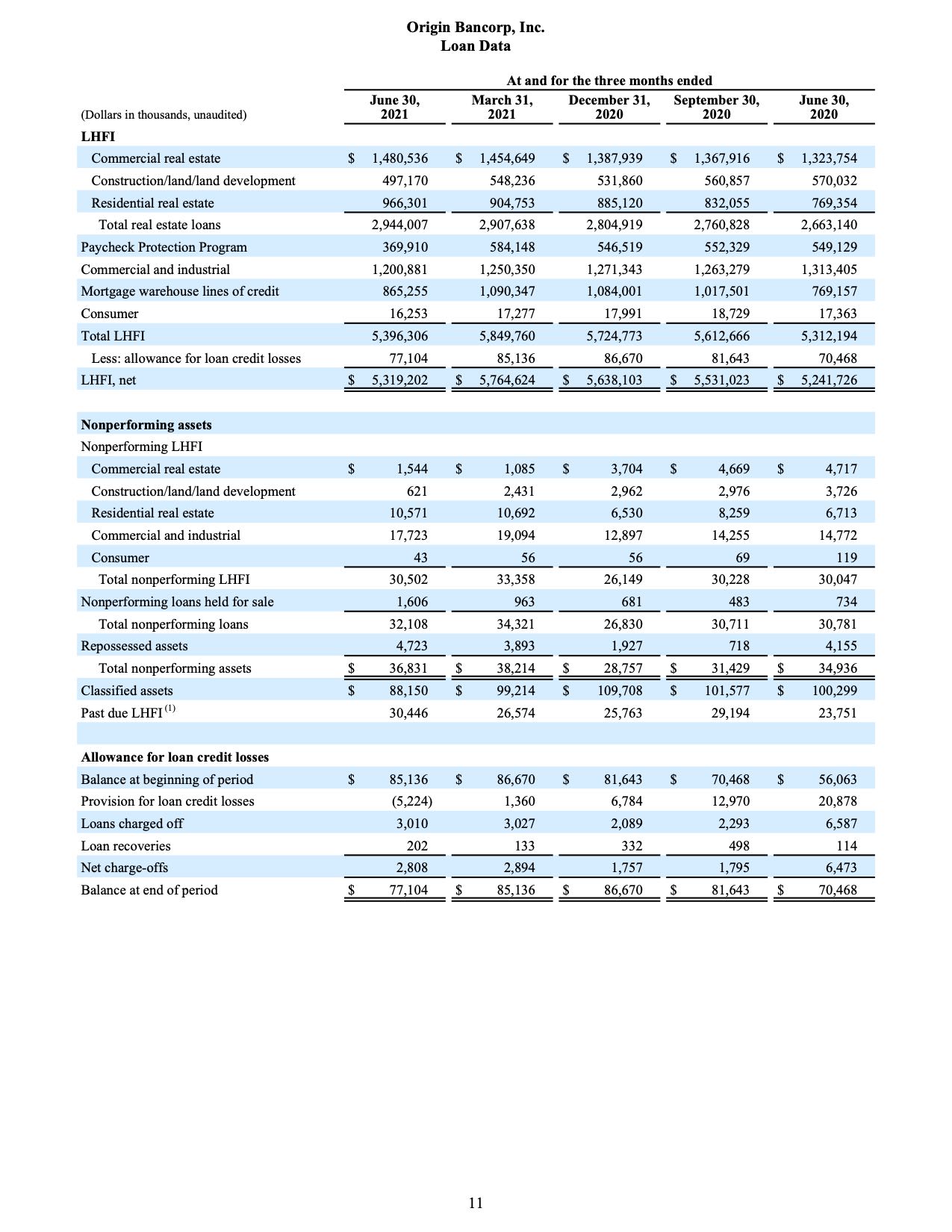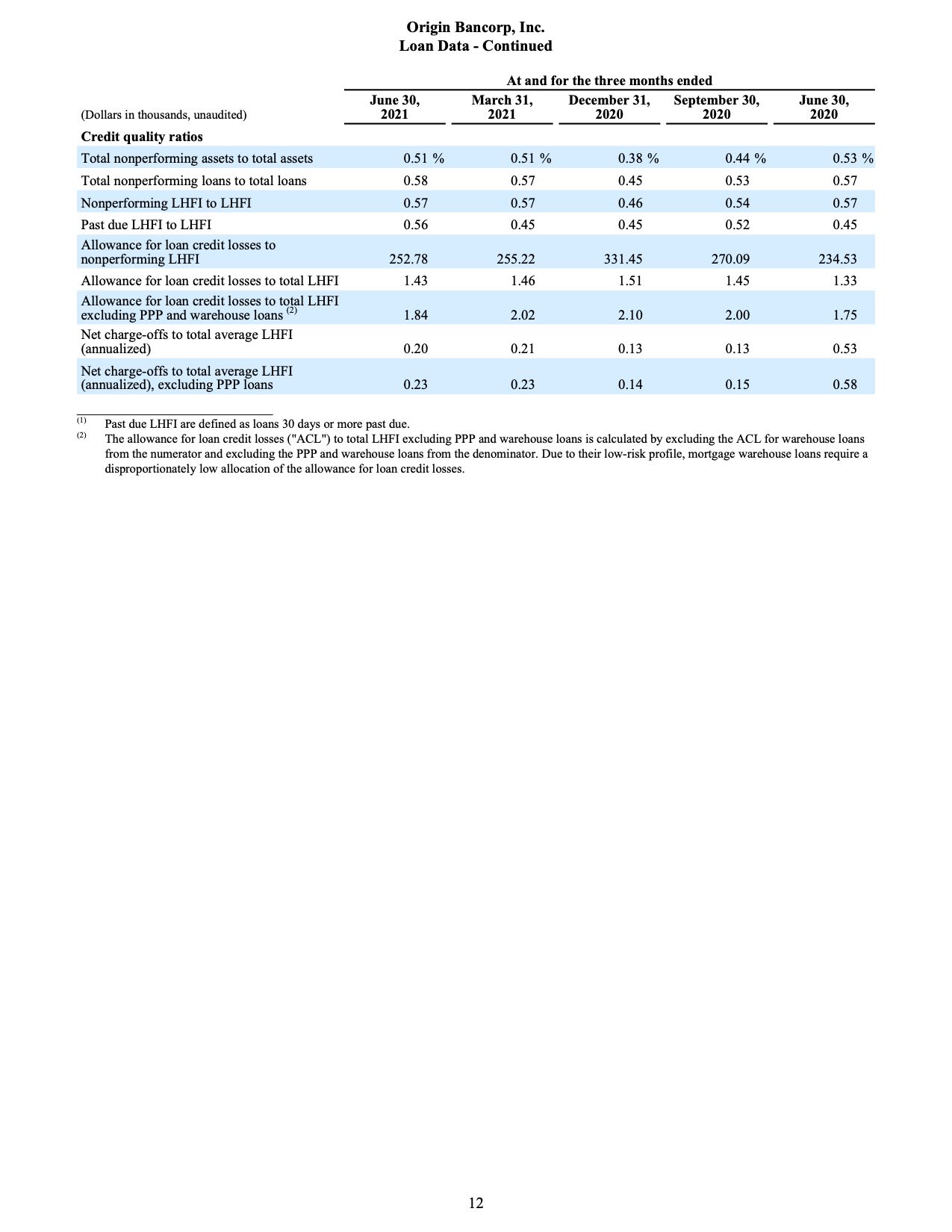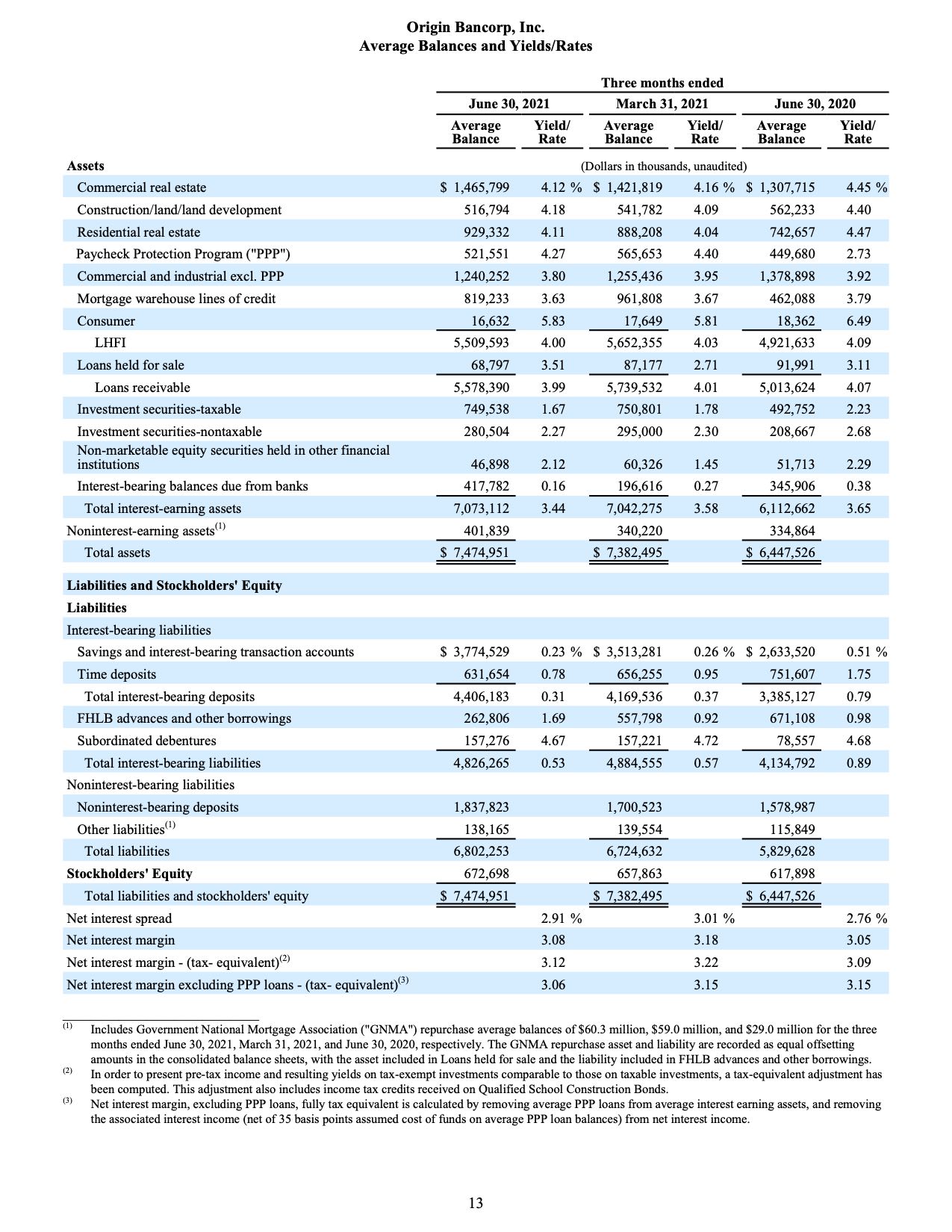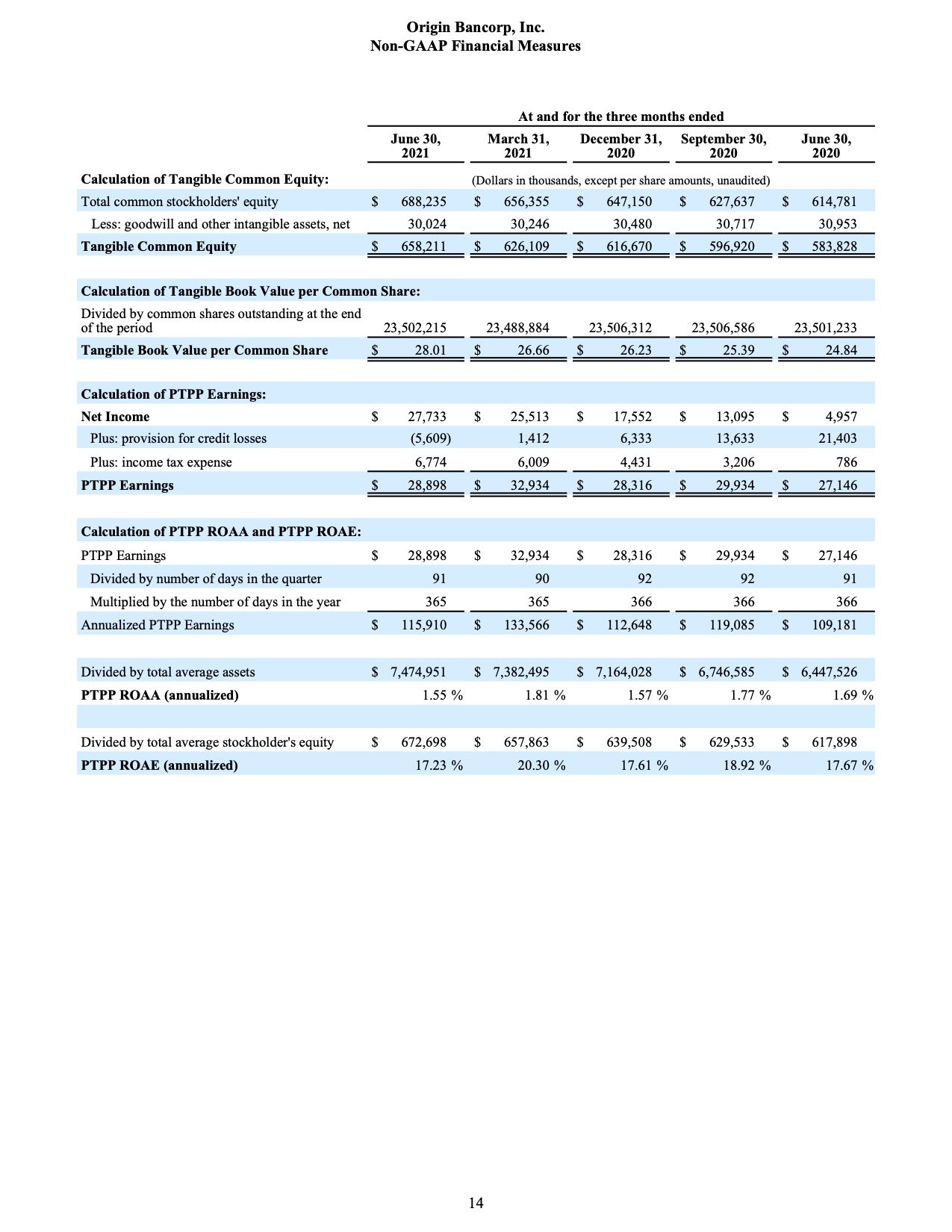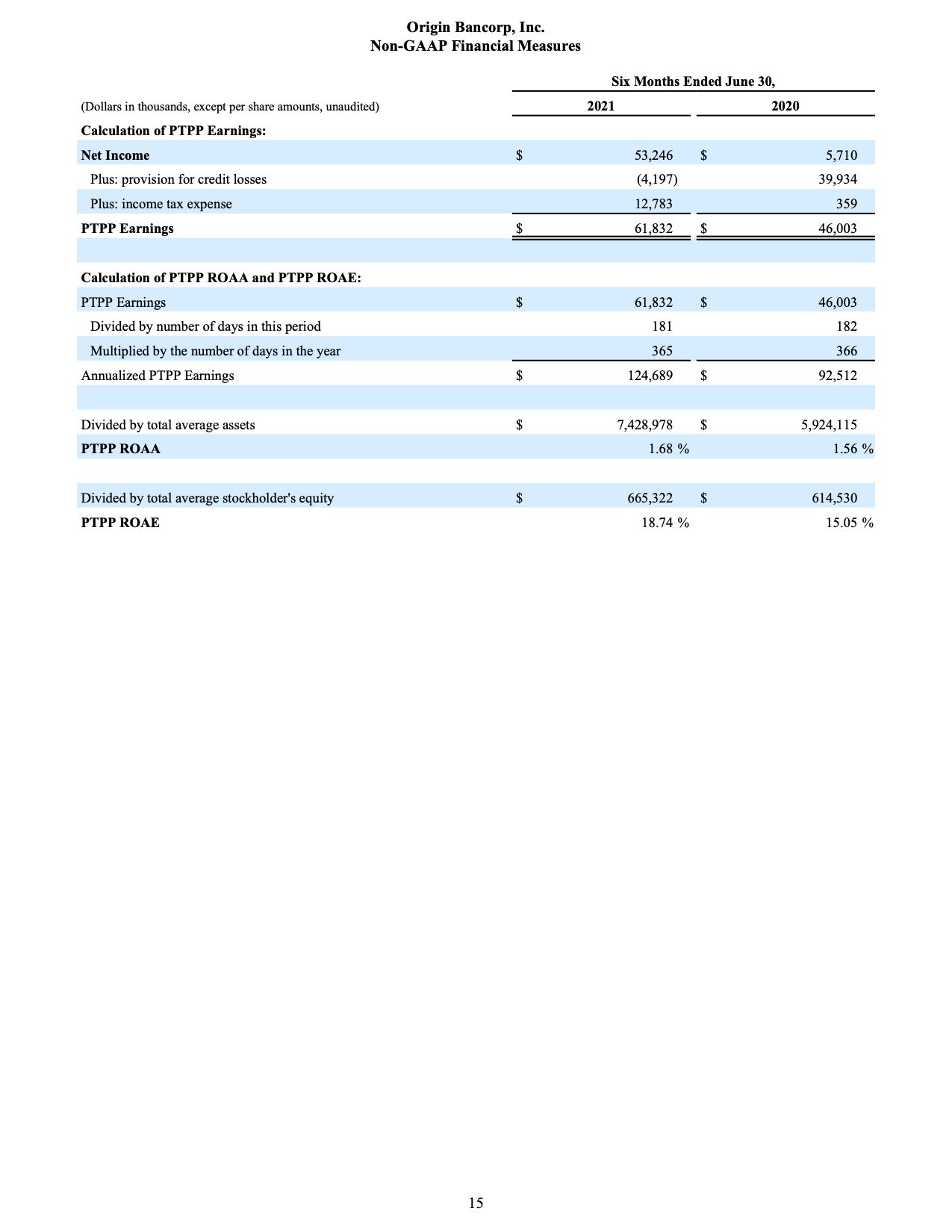Origin Bancorp, Inc. Reports Earnings for Second Quarter 2021
RUSTON, Louisiana (July 28, 2021) - Origin Bancorp, Inc. (Nasdaq: OBNK) ("Origin" or the "Company"), the holding company for Origin Bank (the "Bank"), today announced record net income of $27.7 million for the quarter ended June 30, 2021. This represents an increase of $2.2 million from the quarter ended March 31, 2021, and an increase of $22.8 million from the quarter ended June 30, 2020. Diluted earnings per share for the quarter ended June 30, 2021, were $1.17, up $0.09 from the linked quarter and up $0.96 from the quarter ended June 30, 2020. Pre-tax, pre-provision earnings for the quarter were $28.9 million, a decrease of 12.3% on a linked quarter basis, and a 6.5% increase on a prior year quarter basis.
“Origin delivered strong second quarter results hitting another all-time quarterly net income high” said Drake Mills, chairman, president and CEO of Origin Bancorp, Inc. “Our capital and reserve levels reflect a very strong balance sheet and our employees remain focused on continuing to build long-term value for all of our stakeholders."
Financial Highlights
- Net income was $27.7 million for the quarter ended June 30, 2021, achieving another all-time quarterly high compared to $25.5 million for the linked quarter and $5.0 million for the quarter ended June 30, 2020.
- Net interest income was $54.3 million for the quarter ended June 30, 2021, compared to $55.2 million for the linked quarter and $46.3 million for the quarter ended June 30, 2020.
- Credit loss provision was a net benefit of $5.6 million for the quarter ended June 30, 2021, compared to a provision expense of $1.4 million for the linked quarter and $21.4 million for the quarter ended June 30, 2020.
- Cost of total deposits was 0.22% for the quarter ended June 30, 2021, compared to 0.26% for the linked quarter and 0.54% for the quarter ended June 30, 2020.
- Annualized returns on average equity and average assets were 16.54% and 1.49%, respectively, for the quarter ended June 30, 2021, compared to 15.73% and 1.40%, respectively for the quarter ended March 31, 2021, and 3.23% and 0.31%, respectively, for the quarter ended June 30, 2020.
Results of Operations for the Three Months Ended June 30, 2021 Net Interest Income and Net Interest Margin
Net interest income for the quarter ended June 30, 2021, was $54.3 million, a decrease of $947,000, or 1.7%, compared to the linked quarter. The decrease was primarily due to a $1.3 million decrease in interest income earned on the total loan portfolio offset by a $372,000 decrease in deposit costs. The decrease in interest income earned on the total loan portfolio was primarily driven by a $161.1 million decrease in the average balance of total loans caused primarily by a $142.6 million decrease in average mortgage warehouse lines of credit loan balances. The decrease in deposit costs was primarily due to a reduction in deposit rates. The average rate on time deposits decreased to 0.78% for the current quarter, down from 0.95% for the linked quarter. The average rate on interest-bearing deposits was 0.31% for the current quarter, down from 0.37% for the linked quarter.
The yield earned on interest-earning assets was 3.44%, a decrease of 14 basis points compared to the linked quarter and a 21 basis point decrease compared to the quarter ended June 30, 2020. Excluding PPP loans, the yield earned on interest- earning assets was 3.37%, a 14 basis point decrease compared to the linked quarter. The rate paid on total interest-bearing liabilities for the quarter ended June 30, 2021, was 0.53%, representing a decrease of four basis points and 36 basis points compared to the linked quarter and the quarter ended June 30, 2020, respectively.
The fully tax-equivalent net interest margin ("NIM") was 3.12% for the current quarter, a 10 basis point decrease from the linked quarter and a three basis point increase from the quarter ended June 30, 2020. Excluding PPP loans, the fully tax- equivalent NIM was 3.06%, a nine basis point decrease from the linked quarter. The primary driver of the NIM decrease was an increase in liquidity due to a shift in balance sheet composition. The average balance of interest-bearing balances due from banks increased $221.2 million during the quarter ended June 30, 2021, while the yield decreased by 11 basis points from the linked quarter.
Credit Quality
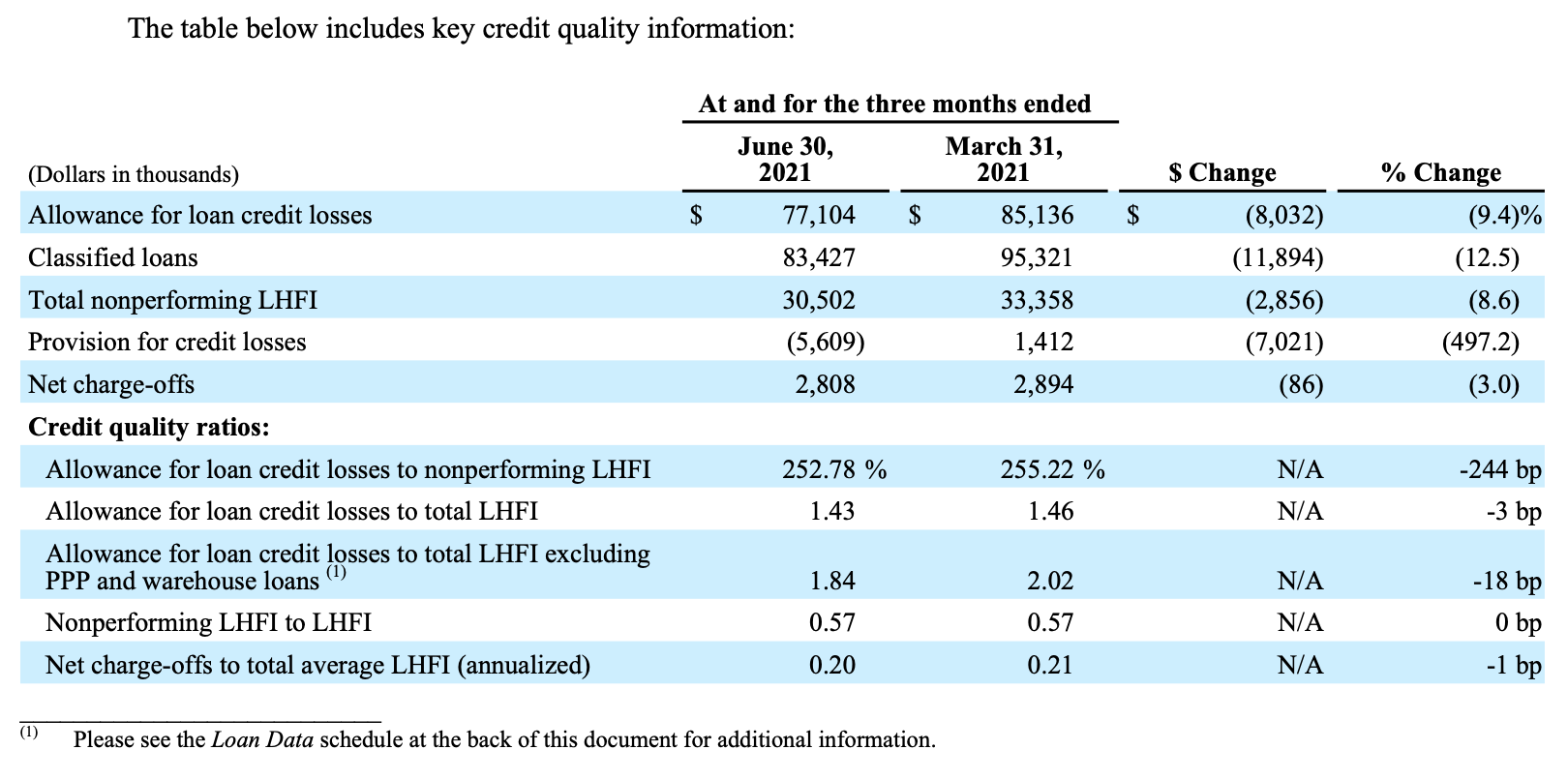
The credit loss provision net benefit compared to the provision expense for the quarter ended March 31, 2021, was primarily due to a release of allowance of $5.6 million during the current quarter driven by continued improvement in forecasted economic conditions, at June 30, 2021. While economic forecasts have improved, uncertainty remains for the remainder of the 2021 year due to risks related to the resurgence or lingering effects of COVID-19, inflationary and labor pressures as well as continued supply-chain disruptions.
The Company's quarterly net charge-offs were stable with the linked quarter, and decreased $3.7 million compared to the quarter ended June 30, 2020. Classified loans declined $11.9 million at June 30, 2021, compared to March 31, 2021, and represented 1.66% as a percentage of LHFI, excluding PPP loans, and 9.53% as a percentage of total risk-based capital (at the Origin Bancorp, Inc. level) compared to 1.81% and 11.10%, respectively, at March 31, 2021.
Noninterest Income
Noninterest income for the quarter ended June 30, 2021, was $12.4 million, a decrease of $4.7 million, or 27.4%, from the linked quarter. The decrease from the linked quarter was primarily driven by decreases of $1.8 million, $1.7 million, $971,000 and $721,000 in mortgage banking revenue, gain on sales of securities, net, limited partnership investment income, and insurance commission and fee income, respectively, which was partially offset by a $554,000 increase in other noninterest income. The decreases in gain on sales of securities, net, limited partnership investment income, and insurance commission and fee income were primarily driven by linked quarter recorded income that was higher than the quarterly trends typically experienced.
The $1.8 million decrease in mortgage banking revenue is mainly due to a lower gain on sales of $2.7 million, due to a 25.3% decrease in sales volume and an 17.4% decrease in sales margin. This decline was partially offset by a $1.2 million increase in the impact of the mortgage pipeline valuation due to the increased market interest rates.
The $554,000 increase in other noninterest income was driven by a $349,000 increase in fair value option loans, securities and related swaps during the current quarter compared to the linked quarter. At June 30, 2021, the Company had $28.4 million of fair value option loans and securities, and swings in value quarter to quarter can be caused by changes in benchmark interest rates and curves, such as United States Treasury rates.
Noninterest Expense
Noninterest expense for the quarter ended June 30, 2021, was $37.8 million, a decrease of $1.6 million, compared to the linked quarter. The decrease from the linked quarter was largely driven by decreases of $1.7 million and $626,000 in other noninterest expense and regulatory assessments, respectively, which was partially offset by an increase of $449,000 in loan related expenses.
The $1.7 million decrease in other noninterest expense was due to a $1.6 million payment related to the early termination of long-term Federal Home Loan Bank ("FHLB") advances last quarter with no similar transaction during the quarter ended June 30, 2021.
The $626,000 decrease in regulatory assessments compared to the linked quarter was due to a $280,000 accrual release from the first quarter 2021 as a result of FDIC assessments.
The increase in loan related expenses was primarily due to an increase of $330,000 in loan-related legal fees and repossession costs recorded in conjunction with workout credits.
Financial Condition
Loans
- Total LHFI decreased $453.5 million compared to the linked quarter and increased $84.1 million compared to June 30, 2020.
- Mortgage warehouse lines of credit decreased $225.1 million compared to the linked quarter and increased $96.1 million compared to June 30, 2020.
- PPP loans, net of deferred fees and costs, totaled $369.9 million at June 30, 2021, a decrease of $214.2 million compared to the linked quarter. Net deferred loan fees and costs on PPP loans were $9.3 million at June 30, 2021.
- Average LHFI decreased $142.8 million, compared to the linked quarter, and increased $588.0 million compared to June 30, 2020.
Total LHFI at June 30, 2021, were $5.40 billion, reflecting a decrease of 7.8% compared to the linked quarter and an increase of 1.6%, compared to June 30, 2020. The decrease in LHFI compared to the linked quarter, was primarily driven by decreases in mortgage warehouse lines of credit and PPP loans, respectively. Higher mortgage interest rates during the period and a decline in mortgage refinancing activity were the largest drivers of the lower mortgage warehouse volumes from the abnormally high levels seen in the recent past. PPP loans have decreased primarily due to $230.2 million in PPP loan principal forgiveness experienced during the quarter. Total LHFI at June 30, 2021, excluding PPP and mortgage warehouse lines of credit, were $4.16 billion, reflecting a $14.1 million or 0.3% decrease compared to the linked quarter and an increase of $167.2 million, or 4.2% compared to June 30, 2020. During the quarter ended June 30, 2021, we proactively reduced $47.0 million of outstanding loan balances that were previously identified as work out credits.
Deposits
- Total deposits decreased $317.8 million compared to the linked quarter and increased $656.1 million compared to June 30, 2020.
- Brokered deposits decreased by $571.7 million and $490.9 million compared to the linked quarter and June 30, 2020, respectively.
- Average total deposits for the quarter ended June 30, 2021, increased by $373.9 million and $1.28 billion over the linked quarter and the quarter ended June 30, 2020, respectively.
Total deposits at June 30, 2021, were $6.03 billion, reflecting a decrease of 5.0% compared to the linked quarter and an increase of 12.2% compared to June 30, 2020. The decrease from the linked quarter was caused by a decrease in brokered deposits in response to funding needs during the quarter. The decrease was partially offset by a $187.2 million increase in deposits from business depositors.
Increases of $730.3 million and $267.7 million in deposits from business depositors and public funds, respectively, drove the increase in total deposits compared to June 30, 2020, which was offset by a $490.9 million decrease in brokered deposits.
For the quarter ended June 30, 2021, average noninterest-bearing deposits as a percentage of total average deposits was 29.4%, compared to 29.0% for the quarter ended March 31, 2021, and 31.8% for the quarter ended June 30, 2020.
Borrowings
- Average FHLB advances and other borrowings for the quarter ended June 30, 2021, decreased by $295.0 million and $408.3 million compared to the quarter ended March 31, 2021 and the quarter ended June 30, 2020, respectively.
PPP forgiveness payments continued, non-brokered deposits increased and warehouse loans declined during the quarter ended June 30, 2021, driving an increase in overall liquidity and reducing reliance on borrowings. Average FHLB advances and other borrowings decreased 52.9% and 60.8% for the quarter ended June 30, 2021, compared to the quarter ended March 31, 2021 and to the quarter ended June 30, 2020, respectively. During the quarter ended June 30, 2021, the Company decreased its short-term average FHLB advances to near zero from $278.1 million during the quarter ended March 31, 2021, primarily due to shifts in the composition of the balance sheet.
Stockholders' equity was $688.2 million at June 30, 2021, an increase of $31.9 million compared to $656.4 million at March 31, 2021, and an increase of $73.5 million compared to $614.8 million at June 30, 2020. The increase from the linked quarter was primarily due to net income and other comprehensive income, net of tax for the quarter of $27.7 million and $6.7 million, respectively, which was partially offset by the quarterly dividend declared during the quarter ended June 30, 2021. The increase from the June 30, 2020, quarter was primarily caused by net income retained during the intervening period.
Conference Call
Origin will hold a conference call to discuss its second quarter 2021 results on Thursday, July 29, 2021, at 8:00 a.m. Central Time (9:00 a.m. Eastern Time). To participate in the live conference call, please dial (844) 695-5516; International: (412) 902-6750 and request to be joined into the Origin Bancorp, Inc. (OBNK) call. A simultaneous audio-only webcast may be accessed via Origin's website at www.origin.bank under the Investor Relations, News & Events, Events & Presentations link or directly by visiting: https://services.choruscall.com/mediaframe/webcast.html?webcastid=agVFdi1L.
If you are unable to participate during the live webcast, the webcast will be archived on the Investor Relations section of Origin's website at www.origin.bank, under Investor Relations, News & Events, Events & Presentations.
About Origin Bancorp, Inc.
Origin is a financial holding company headquartered in Ruston, Louisiana. Origin's wholly owned bank subsidiary, Origin Bank, was founded in 1912. Deeply rooted in Origin's history is a culture committed to providing personalized, relationship banking to its clients and communities. Origin provides a broad range of financial services to businesses, municipalities, high net-worth individuals and retail clients. Origin currently operates 44 banking centers located from Dallas/ Fort Worth and Houston, Texas across North Louisiana and into Mississippi. For more information, visit www.origin.bank.
Forward-Looking Statements
This press release contains certain forward-looking statements within the meaning of the Private Securities Litigation Reform Act of 1995. Forward-looking statements include information regarding Origin's future financial performance, business and growth strategy, projected plans and objectives, including the Company’s loan loss reserves and allowance for credit losses related to the COVID-19 pandemic and any expected purchases of its outstanding common stock, and related transactions and other projections based on macroeconomic and industry trends, including expectations regarding efforts to respond to the COVID-19 pandemic and changes to interest rates by the Federal Reserve and the resulting impact on Origin's results of operations, estimated forbearance amounts and expectations regarding the Company's liquidity, including in connection with advances obtained from the FHLB, which are all subject to change and may be inherently unreliable due to the multiple factors that impact broader economic and industry trends, and any such changes may be material. Such forward-looking statements are based on various facts and derived utilizing important assumptions and current expectations, estimates and projections about Origin and its subsidiaries, any of which may change over time and some of which may be beyond Origin's control. Statements or statistics preceded by, followed by or that otherwise include the words "anticipates," "believes," "estimates," "expects," “foresees,” "intends," "plans," "projects," and similar expressions or future or conditional verbs such as "could," "may," “might,” "should," "will," and "would" or variations of such terms are generally forward-looking in nature and not historical facts, although not all forward-looking statements include the foregoing words. Further, certain factors that could affect Origin's future results and cause actual results to differ materially from those expressed in the forward-looking statements include, but are not limited to: the continuing duration and impacts of the COVID-19 global pandemic and continuing development and distribution of COVID-19 vaccines, as well as other efforts to contain the virus's transmission, including the effect of these factors and developments on Origin’s business, customers and economic conditions generally, as well as the impact of the actions taken by governmental authorities to address the impact of COVID-19 on the United States economy, including, any economic stimulus legislation; deterioration of Origin's asset quality; factors that can impact the performance of Origin’s loan portfolio, including real estate values and liquidity in Origin's primary market areas; the financial health of Origin's commercial borrowers and the success of construction projects that Origin finances; changes in the value of collateral securing Origin's loans; Origin’s ability to anticipate interest rate changes and manage interest rate risk; the effectiveness of Origin’s risk management framework and quantitative models; the risk of widespread inflation; Origin’s inability to receive dividends from Origin Bank and to service debt, pay dividends to Origin’s common stockholders, repurchase Origin’s shares of common stock and satisfy obligations as they become due; business and economic conditions generally and in the financial services industry, nationally and within Origin's primary market areas; changes in Origin’s operation or expansion strategy or Origin's ability to prudently manage its growth and execute its strategy; changes in management personnel; Origin's ability to maintain important customer relationships, reputation or otherwise avoid liquidity risks; increasing costs as Origin grows deposits; operational risks associated with Origin’s business; volatility and direction of market interest rates; increased competition in the financial services industry, particularly from regional and national institutions; difficult market conditions and unfavorable economic trends in the United States generally, and particularly in the market areas in which Origin operates and in which its loans are concentrated; an increase in unemployment levels and slowdowns in economic growth; Origin's level of nonperforming assets and the costs associated with resolving any problem loans including litigation and other costs; the credit risk associated with the substantial amount of commercial real estate, construction and land development, and commercial loans in Origin's loan portfolio; changes in the laws, rules, regulations, interpretations or policies relating to financial institutions, and potential expenses associated with complying with such regulations, periodic changes to the extensive body of accounting rules and best practices; further government intervention in the U.S. financial system; compliance with governmental and regulatory requirements, including the Dodd-Frank Wall Street Reform and Consumer Protection Act and others relating to banking, consumer protection, securities and tax matters; Origin's ability to comply with applicable capital and liquidity requirements, including its ability to generate liquidity internally or raise capital on favorable terms, including continued access to the debt and equity capital markets; changes in the utility of Origin's non-GAAP liquidity measurements and its underlying assumptions or estimates; uncertainty regarding the future of the London Interbank Offered Rate and the impact of any replacement alternatives on Origin’s business; possible changes in trade, monetary and fiscal policies, laws and regulations and other activities of governments, agencies and similar organizations; natural disasters and adverse weather events, acts of terrorism, an outbreak of hostilities, regional or national protests and civil unrest (including any resulting branch closures or property damage), widespread illness or public health outbreaks or other international or domestic calamities, and other matters beyond Origin’s control; and system failures, cybersecurity threats or security breaches and the cost of defending against them. For a discussion of these and other risks that may cause actual results to differ from expectations, please refer to the sections titled "Cautionary Note Regarding Forward-Looking Statements" and "Risk Factors" in Origin's most recent Annual Report on Form 10-K filed with the Securities and Exchange Commission and any updates to those sections set forth in Origin's subsequent Quarterly Reports on Form 10-Q and Current Reports on Form 8-K. If one or more events related to these or other risks or uncertainties materialize, or if Origin's underlying assumptions prove to be incorrect, actual results may differ materially from what Origin anticipates. Accordingly, you should not place undue reliance on any forward-looking statements. Any forward-looking statement speaks only as of the date on which it is made, and Origin does not undertake any obligation to publicly update or review any forward-looking statement, whether as a result of new information, future developments or otherwise.
New risks and uncertainties arise from time to time, and it is not possible for Origin to predict those events or how they may affect Origin. In addition, Origin cannot assess the impact of each factor on Origin's business or the extent to which any factor, or combination of factors, may cause actual results to differ materially from those contained in any forward-looking statements. Furthermore, many of these risks and uncertainties are currently amplified by and may continue to be amplified by or may, in the future, be amplified by, the COVID-19 pandemic and the impact of varying governmental responses that affect Origin's customers and the economies where they operate. All forward-looking statements, expressed or implied, included in this communication are expressly qualified in their entirety by this cautionary statement. This cautionary statement should also be considered in connection with any subsequent written or oral forward-looking statements that Origin or persons acting on Origin's behalf may issue. Annualized, pro forma, adjusted, projected and estimated numbers are used for illustrative purpose only, are not forecasts and may not reflect actual results.
Contact:
Chris Reigelman, Origin Bancorp, Inc. 318-497-3177 / chris@origin.bank
